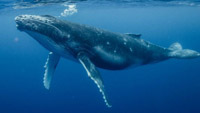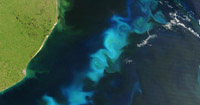by Sammara Audi, Public Relations Intern
As we all know by now, trees are amazing sources of oxygen, taking in carbon dioxide and releasing oxygen into the atmosphere via photosynthesis. Photosynthesis is the process of taking in carbon dioxide and water to produce glucose and oxygen as a by-product. It is primarily used by plants and trees to create their own food. But many different organisms actually release even more oxygen than trees do! In this blog post I’ll be talking about some that may surprise you… starting with whales!
 It has been said that whales could be the key to saving our planet and fighting back against climate change. This is because of the large amount of carbon dioxide whales absorb during their lifetimes! Every great whale absorbs approximately 33,000kg during their lifespan whereas, in comparison, an average tree can only absorb around 22kg of carbon dioxide per year. Whales are the largest organism on our planet and can last underwater without oxygen for around 20 minutes, despite still being mammals. They swim down to feed then rise to the surface to breathe through their blowholes. Whales die when they no longer have the strength to swim to the surface to breathe and sink to the bottom of the ocean.
It has been said that whales could be the key to saving our planet and fighting back against climate change. This is because of the large amount of carbon dioxide whales absorb during their lifetimes! Every great whale absorbs approximately 33,000kg during their lifespan whereas, in comparison, an average tree can only absorb around 22kg of carbon dioxide per year. Whales are the largest organism on our planet and can last underwater without oxygen for around 20 minutes, despite still being mammals. They swim down to feed then rise to the surface to breathe through their blowholes. Whales die when they no longer have the strength to swim to the surface to breathe and sink to the bottom of the ocean.
Sadly, whales are being hunted still to this day, in countries like Iceland, Norway, and Japan. Although whale-hunting bans were initiated around the world years ago, a few countries still take part in whaling, with Japan actually announcing that they resumed whaling practices back in 2019. The population of whales around the world is decreasing, meaning we need to try to save them to save our planet!
Whales have a symbiotic relationship with phytoplankton, meaning they both benefit from each other. Phytoplankton provide whales with the food they need, and whales provide the phytoplankton with the minerals they need from the ocean to become fertilized and reproduce, which helps phytoplankton to prosper as a species. Luckily for us this means that wherever whales are found, phytoplankton are as well!

An oceanic phytoplankton bloom in the South Atlantic Ocean
These creatures are buoyant and float closer to the surface of the ocean in order to reach enough sunlight for photosynthesis. They provide food for a wide range of sea creatures like whales (as mentioned above), shrimp, and jellyfish. Phytoplankton absorb 40% of all the carbon dioxide in the atmosphere, which is equal to the amount that 1.7 trillion trees do! Not to mention, around 70% of all the oxygen in the atmosphere comes from marine plants and plant-like organisms, making them the primary source of oxygen.
All of this sounds amazing, but just as whales are facing threats from hunting and whaling practices, the population of phytoplankton in the ocean is decreasing due to the rising temperature of the sea surface. Once again, a marvelous solution to climate change is threatened by the consequences of our human actions. How is it that we as a species often hurt the very things that could save us?
What can you do to help as an individual living on our planet? Check out our website for ways to get involved in urban forestry, and act now to save our planet!